|
|
| How
To |
Condiments |
|
Virtually all kitchens in China, whether
they be in private homes or restaurants, all tend to
have a basic stock of ready ingredients. The same is
true for table, so here we list the most common or useful
ones for foreigners, and explain what others are that
you may not be familiar with.
Note: My own table always has Table (refined) Salt and
Ground Black Pepper. Chinese tables do not.
| Category |
|
Comments |
|
| |
|
|
|
Cooking Oil
or
yao |
|
This is the most important ingredient in any
Chinese kitchen.
1. By
far the most common type is peanut oil, which
is very cheap and totally disgusting!
2. High quality 'ground nut'
oil is simply refined peanut oil, and this is
expensive.
3. Corn or
Maize oil is common and ok, but perhaps doesn't
reach the temperatures we are used to in the west.
4. Sunflower Oil is not
so common, but available in most supermarkets
- and worth looking for.
5. Olive
Oil is beginning to take a large share of the
high-end luxury oil market throughout China. It
is used as a condiment or cold ingredient, and
totally unsuitable for stir-fry. I doubt the cheaper
versions have any virgins in them at all! |
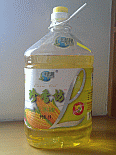
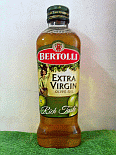
|
| |
|
|
|
| Salt or yim |
|
Chinese kitchens always have salt, which
is available in many sizes of grain. The bag pictured
right is table salt and cost around Y4.
Chinese chef's do not use monosodium glutamate
(in China). |
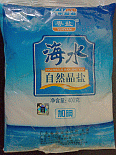 |
| |
|
|
|
| Pepper |
|
Black peppercorns are found in every kitchen.
Some kitchens may have ground white and/or black
pepper in the cupboard somewhere. |
 |
| |
|
|
|
Rice Wine
or
ba zhou |
|
Many Chinese dishes contain a nip of rice wine.
This is usually the cheaper type which costs a
few RMB per bottle, pictured right.
Most tables will have a higher quality rice wine
for drinking with the meal, with a typical cost
of between 40 and 70 RMB.
The best rice wine is called Mou Tao, and costs
several hundred RMB a bottle, but it is very well
worth it. |
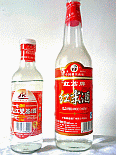 |
| |
|
|
|
Soy Sauce
or
Xi Yao |
|
Soy sauce is a basic ingredient of many Cantonese
dishes, and is also used as a dip at table.
China generally only has one type of Soy Sauce,
although taste and quality vary enormously. We
think the best is made in Hoi Peng City, Guangdong
(开平 or Kai Ping in Mandarin). In the picture (right)
this is written as 广东省 开平市(Guangdong Province,
Kai Ping City).
It is light and flavoursome without being overpowering,
acid, or sour. There are several manufacturers
in this southern city, and they all seem to sell
their soy sauce in square shaped bottles, which
is most unusual. Their products are good for both
kitchen and table. Highly recommended.
|
 |
| |
|
|
|
| Soy Sauce Dips |
|
A small bowl of soy sauce if often provided
at table for dipping, and may have other ingredients
in it as listed below:
1. A squeeze of Wasabi. Normally presented with
hot dried squid.
2. Finely diced ginger, chopped spring onions
(Scallions) and diced coriander leaves. Stir and
leave to marinade for a few minutes. This is served
with Sik Juk (Congee in Hong Kong parlance, or
Rice Porridge).
3. Thinly chopped chilli rings. Again, leave these
to marinade in the soy sauce for a few minutes,
and use a deeper bowl perhaps? |
|
| |
|
|
|
Sugar, Honey
and Sweet Bamboo
These now have their own dedicated page - Click
for Sugar |
| |
|
|
|
Chicken Bouillon
or
gai ze'ing |
|
This is a standard feature of every Chinese
kitchen, and is used commonly whenever a dish
requires a little gravy type sauce.
Chef's normally add a teaspoon of granules directly
to the food in the wok and stir fry, adding extra
fluid (usually water) as required. |
 |
| |
|
|
|
Chilli and
Chilli Sauces
now have their own dedicated page - click
for Chillis |
| |
|
|
|
| Blackbean Sauce |
|
Nearly all Cantonese kitchens have a large jar
of Blackbean sauce. It is used in many dishes,
and some of these may surprise you. Most commonly
it is added to meat and seafood for a distinctive
and spicy sauce. Chinese spare ribs - the ones
that are about an inch square will often be cooked
with this sauce. |
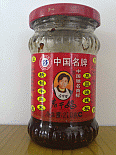 |
| |
|
|
|
| Coriander |
|
Fresh coriander leaves are a basic ingredient
of the majority of Chinese cooking, but are also
used as garnish and used to embellish the table
- see soy sauce dips above. |
 |
| |
|
|
|
| Plum Sauce |
|
Plum sauce is fairly common in Cantonese kitchens,
but is not an essential. This sweet sauce is used
as is, or combined with other ingredients for
certain dishes.
It is one of the basic ingredients of 'Sweet and
Sour' sauce, which is always made and never bought
ready mixed. It is also used as a sauce for things
like 'Western Style' spare ribs, where it may
be combined with black pepper or chilli.
Plum Sauce can also be served at table as a dip
for specific dishes such as suckling pig. |
 |
| |
|
|
|
| Oyster Sauce |
|
This is a sweet and flavoursome fish sauce that
slightly tastes of Oysters. It is not commonly
used by Cantonese chef's in China, and provides
the basis for specific seafood sauces for special
dishes. It is commonly used for dressing Abalone. |
|
| |
|
|
|
| Hoi Sin Sauce |
|
This means Fish Sauce, but it is not commonly
used by Cantonese chef's
1. Bottled fish sauce is used as a fish stock
and is normally shaken direct from the bottle
into the wok.
2. The thicker fish paste is used as a base for
specific fish sauces. |
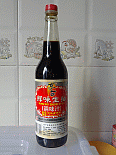 |
|
|
|
This information is as supplied by ourselves, and ably
supported by our friends and various internet portals. |
|
|